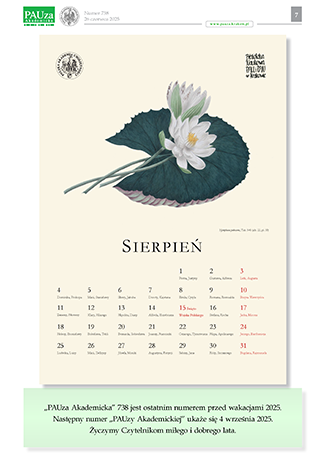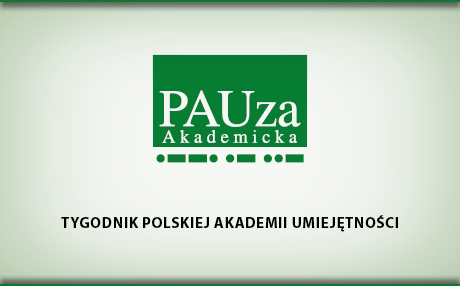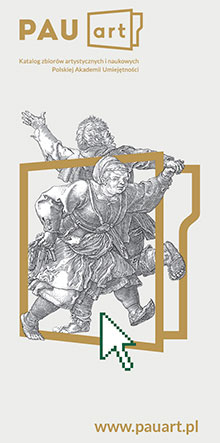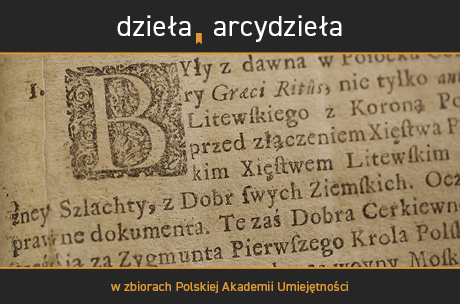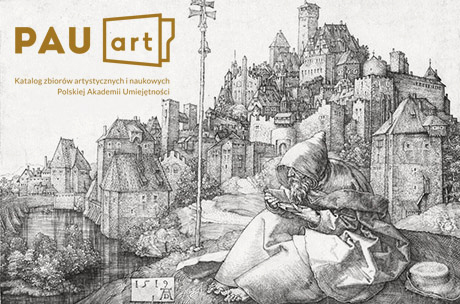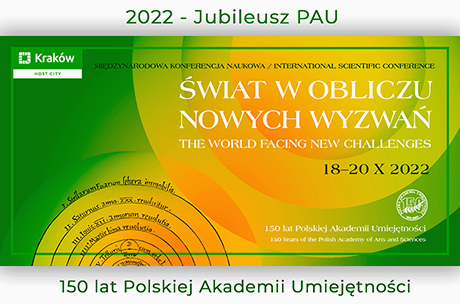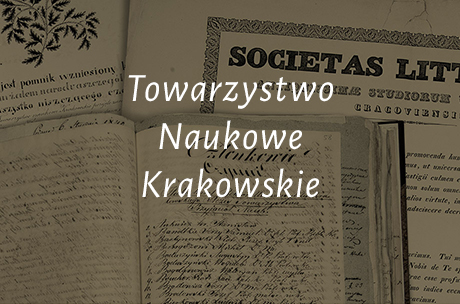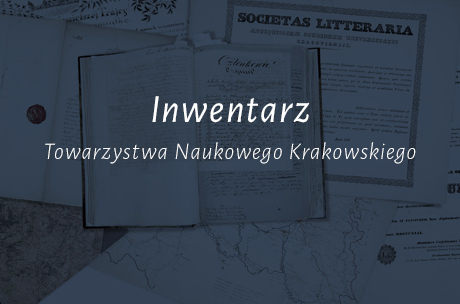Lanckoroński Foundation Scholarships
Lanckoroński Foundation and De Brzezie Lanckoroński Foundation Scholarships
The Polish Academy of Arts and Sciences disburses the Lanckoroński Foundation and the De Brzezie Lanckoroński Foundation scholarships for research conducted in Rome, Vienna, London, and other centres of learning in Europe.
As a result of an agreement between the Lanckoroński Foundation and the Polish Academy of Arts and Sciences of 6 and 23 October 1995, which was expanded to include the Brzezie Lanckoroński Foundation and supplemented on 12 September 2012, the two foundations transferred the management of their scholarships, which they had been awarding to Polish humanists for research abroad for many years, to PAU. According to the agreement, and in line with established practice, in principle only archaeologists who study the Mediterranean, historians, art historians, classicists, and historians of philosophy can apply for scholarships.
The range of topics covered by historians, art historians, and historians of philosophy should not extend beyond 1939 and can only extend to 1989 in exceptional cases. The scholarships are awarded annually by a commission at PAU, which is made up of two PAU members, a secretary representing PAU, and representatives from the Jagiellonian University, the University of Warsaw, the University of Wrocław, the Adam Mickiewicz University of Poznań, and the Nicolaus Copernicus University in Toruń. Commission sittings are attended by representatives of both foundations, who are designated by the foundations’ presidents.
Lanckoroński Photothèque
The PAU Lanckoroński Photothèque represents a part of the ‘collection of scientific photographs’ that Count Karol Lanckoroński donated to PAU in 1929.
At the time, it contained, ‘more or less 60,000 photographs […] of works of art from the fields of architecture, sculpture, and painting, with a special focus on Italian art.’
In reality, however, the PAU Lanckoroński Photothèque currently contains a little over 40,000 original positive prints.
In accordance with the wishes of Karol Lanckoroński, the collection was first sent to the PAU Arts and Science Base in Rome.
Eventually, however, most of it arrived in Kraków and it is now housed in the main building of the Polish Academy of Arts and Sciences on ul, Sławkowska in that city.
The collection of the PAU Lanckoroński Photothèque contains only positive prints.
A significant proportion of these are works by the best photographers of the time and from the most famous European publishers and ateliers.
The subjects of the photographs, in addition to the celebrated works mentioned before (from antiquity to the nineteenth century), also include archaeological expeditions to Asia Minor and Karol Lanckoronski's numerous journeys of exploration.
However, there are no family photographs or photographs showing the interiors of palaces belonging to the Lanckoroński family.
Even though an inventory of the collection is being taken, and it is gradually being digitalised, the photographs are sometimes exhibited.
To date, the PAU Lanckoroński Photothèque has presented selected photograms (or their reproductions) at the following exhibitions:
– From the Lanckoroński Photothèque (PAU and PAN Scientific Archive in Kraków, 2009);
– Nineteen, nineteenth-century British photographs (Association of Art Historians, Kraków branch, 2010);
– Fashion in the nineteenth century Islamic world… Photographs from the collection of Count Karol Lanckoroński (Space Gallery, Kraków, 2013);
– Stories told in photographs (PAU and PAN Scientific Archive in Kraków, 2013);
– Lanckoroński’s Vienna (Vienna PAU Arts and Science Base, 2013);
– Exhibition of historical photographs from the Lanckoroński Photothèque (Polish Institute in Rome, 2014);
– Roman sculpture in old photographs (Space Gallery, Kraków, 2014).
Selected photographs from the PAU Lanckoroński Photothèque are sometimes also made available to the public during exhibitions organised by other institutes of culture, including the PAU and PAN Scientific Archive in Kraków and the PAU and PAN Academic Library in Kraków.
The PAU Lanckoroński Photothèque also promotes its holdings of photography by attending academic conferences and making photographs available to scholars to aid them in their research.
The picture librarian at the Photothèque is dr Adam Korczyński (This email address is being protected from spambots. You need JavaScript enabled to view it. )
International cooperation
From the moment it was established, the Academy of Arts and Sciences (AU) cultivated links with other countries and made a point of acting at the international level. In the nineteenth century, it initiated archival expeditions to collect and research sources for Polish history (including what was known as the Roman Expedition to the Vatican Archives – the name being connected with the opening of the archives in 1881) and sent its representatives to international congresses.
In 1893, AU became the owner of the Polish Library in Paris Polish Library in Paris and opened an Arts and Science Base there. Beginning from when it was opened, the AU’s library in Kraków was very involved in international inter-library loans. PAU (the AU had become the PAU following World War I) was a founder member of Union Académique Internationale (UAI), which was established in 1921.
PAU’s membership of UAI was restored in 1993 (PAU had been suspended in 1952–1989), and it then took part in UAI research and publication programmes.
- Corpus Vasorum Antiquorum (CVA)
- Tabula Imperii Romani (TIR)
- Atlas du Monde Grec et Romain
- Corpus Antiquitatum Americanensium (CAA)
- Sylloge Nummorum Graecorum (SNG)
- Corpus Philosophorum Medii Aevi
- Civitas Litteraria Europaea
- Moravia Magna
- Monumenta Palaeographica Medii Aevi
- Mundus Scytho-Sarmaticus et Graeco-Romanus
- Catalogue of Islamic Art
- Objects in Central Europe
- Corpus Byzantinum
Thanks to the effective cooperation between PAU and UAI, the latter’s annual plenary congress was held in Kraków in 1999. PAU’s representative at UAI, PAU member Janusz K. Kozłowski, was selected to join the office of UAI. He was its vice president from 2007, its president from 2010, and its honorary president from 2013. UAI has more than 100 member academies in a total of 63 countries.
PAU also works with another organisation whose membership includes academies from a large number of countries: ALLEA (All European Academies), whose headquarters are in Amsterdam. PAU has taken advantage of the forum ALLEA provides to make contributions on the ethics of science and its organisation, and on copyright and the protection of personality rights. PAU took part in European Science Foundation research-programme assessments carried out by ALLEA. In March 2006, PAU hosted and co-organised (with PAN) the ALLEA General Assembly, which we regard as an honour. From 2016, PAU took part in the SAPEA and AGATE programmes run by ALLEA. In 2021, all resolutions, votes, and meetings of members took place remotely.
It should be emphasised that ALLEA has devoted a great deal of attention on its website to publications on the current epidemiological situation and has constantly addressed the coronavirus issue – in its medical, economic, and social contexts.
PAU has signed cooperation agreements with the following foreign institutions:
Slovak Academy of Sciences. Cooperation has been especially fruitful in archaeology; joint field research has been carried out, including at archaeological sites in eastern and south-western Slovakia and into the archaeology and environment of the Low Beskids. The results of this research have been published in two large volumes of Prac Komisji Prehistorii Karpat [Proceedings of the Commission for the Prehistory of the Carpathians] and in a joint volume of the two academies.
Czech Academy of Sciences – here, cooperation between the PAN and PAU Scientific Archive in Kraków and the Archive of the Czech Academy of Sciences – entailing exchanges of knowledge and experience, research visits to archives and libraries, and joint conferences and publications – has flourished. The cooperation of Czech and Polish archaeologists within the framework of this agreement also resulted in a major joint publication.
PAU's cooperation with Hungary is twofold. On the one hand, its archaeologists have carried out joint excavations with the Institute of Archaeology at Eötvös Loránd University and have published the results of these excavations in a joint publication (2 volumes). On the other, scientific exchanges of personnel and joint scientific conferences are organised, mainly for historians, within the framework of the agreement between PAU and the Hungarian Academy of Sciences .
PAU’s agreements with the academies of science of Slovenia , Macedonia, and Romania have so far produced only sporadic exchanges of personnel.
Joint archaeological research in the valley of the Dniester has been a prominent feature of PAU’s cooperation with the National Academy of Sciences of Ukraine. The findings of this work have been published in a volume of Prac Komisji Prehistorii Karpat [Proceedings of the Commission for the Prehistory of the Carpathians] and in two publications issued jointly by the two academies.
Looser forms of cooperation link PAU with the Saxon Academy of Sciences and Humanities, the Austrian Academy of Sciences (a four-volume joint publication of W. Leitsch’s work on the court of Sigismund III Vasa and participation in annual assemblies), with the Berlin-Brandenburg Academy of Sciences and Humanities, and the Academy of Athens (a joint two-volume publication of the results of archaeological research in the Greek islands).
Faculty II of PAU has signed a cooperation agreement with the Lithuanian Institute of History in Vilnius (2009) and with the Polish Scientific Society in Żytomierz (2010; from 2011 there has been a joint yearbook Studia Politologica Ucraino-Polona [Ukrainian-Polish Political Studies], volume I 2011, volume II 2012).
PAU's international cooperation is also enshrined in agreements concluded by the Ministry of Foreign Affairs, including with France, Italy, the Czech Republic, Macedonia, and Egypt.
A representative of PAU, who at the same time is also a representative of Poland, participates in the work of the international committee Thesaurus Linguae Latinae that is run by the Bavarian Academy of Sciences and Humanities.
In 1994, a PAU Arts and Science Base was established in New York under the auspices of the Polish Institute of Arts and Sciences in America , which kept the PAU tradition alive during World War II (from 1942) and during PAU’s suspension in 1952–1989. It was not possible to continue its brief period of activity owing to a lack of funds. We are striving to revive it.
For now, PAU is sharing the costs of publishing Polish Review, which is the organ of the Polish Institute of Arts and Sciences in America and, since 2014, has been a joint quarterly.
Contacts were also established with the Polish Institute of Arts and Sciences in Canada, which was established in 1943 as a branch of the Polish Institute of Arts and Sciences in New York and which has operated as an independent Canadian institute since 1976. It too assumed the status of a PAU Arts and Science Base. PAU and the Canadian base have already published five books together and PAU also supports the Canadian base by sending speakers. In addition, it provides financial support to the base and jointly organises some of its academic sessions.
PAU has become involved with the programme of the Polish Institute of History in Rome, which is financed by the Lanckoroński Foundation. When the institute was dissolved following the death of Karolina Lanckorońska, PAU took over a large number of its publications, including editing and issuing the Records of the Apostolic Nunciature in Poland (Acta Nuntiaturae Polonae). So far, 21 volumes have appeared under the PAU imprint in this series (24 volumes had already been issued in Rome).
Mention should be made of some foreign PAU research not based on formalised agreements between academies. One example was dr hab. Jan Chochorowski’s archaeological excavation of a Scythian barrow in Ryzhanovka, Ukraine, which was supported financially by PAU and which drew on the traditions of the institution. This research produced spectacular results in 1995–1998.
PAU also supported PAU member Jan Machnik's archaeological research into a Transnistrian settlement before grants from Komitet Badań Naukowych [State Committee for Scientific Research] could be obtained for the purpose.
Similarly, following on from pre-war intentions, PAU has contributed to archaeological research in Greece on a sequence of strata in Cave No. 1 in Klissoura (eastern Peloponnese), unique in that part of Europe, which contains traces of settlement and palaeontological finds from the period of the last glaciation. This research contributes to our understanding not only of the evolution of culture within Greece, but also of climatic and palaeoecological changes over the last 100,000 years. These enquiries were led by PAU member Janusz K. Kozłowski – first with the support of PAU and later with the support of research grants. The results of the Klissoura research were published jointly by the Academy of Athens and PAU. Pursuant to the agreement on cultural cooperation between Poland and Egypt, PAU – together with the Institute of Archaeology of the Jagiellonian University – has participated in archaeological research in the Nile Delta.
PAU is now conducting well over a dozen research projects, which are supported by the Ministry of Education and Science (now National Science Centre and National Programme for the Development of the Humanities). PAU has also benefited from grants awarded by the Senate of the Republic of Poland, the Ministry of Foreign Affairs, the Ministry of Culture and National Heritage, and the Małopolska Voivodship Regional Operational Programme.
The indefinite grant from the Lanckoroński Foundation for the publication of Acta Nuntiaturae Polonae series at PAU has already been mentioned.
Go to the project’s website: Nuntiaturae Polonae.
PAUart
PAUart
This is a catalogue of iconographic artistic and scientific collections owned by PAU and partner institutions – primarily PAN and the Historical and Literary Society of Paris. The funds required to maintain it have been obtained from a variety of sources, including the Ministry of Culture and National Heritage, the National Programme for the Development of the Humanities, and the Małopolska Voivodship Regional Operational Programme.
Three stages of the project have so far been completed. The fourth is nearing completion, and a fifth is being planned.
Stage I, 2014:
Nine thousand objects were digitised, processed, and published, including 2,500 engravings (including masterpieces by Albrecht Dürer and Rembrandt) and 6,500 photographs (including from the collection of Karol Lanckoroński and the legacy of Karolina Lanckorońska). The portal also features albums by Bronisław Piłsudski from Sakhalin and by Michal Greim from Kamieniec Podolski, which are of high scientific and artistic value. The objects made available are held in the collections of the PAU and PAN Academic Library in Kraków, the Lanckoroński Photothèque, and the PAU and PAN Scientific Archive in Kraków.
- Leaflet
- Promotional and informational supplement for Gazeta Wyborcza
- Article in Intermission (no. 277–279)
Stage II, 2015:
A further 6,000 objects were digitised, processed, and published, including 1,500 prints from the Special Drawings Repository of the PAU and PAN Academic Library in Kraków (e.g. Albrecht Dürer, William Hogarth, and Francesco Bartolozzi), 2,000 objects from the Special Collections of the PAU and PAN Academic Library in Kraków (photographs, postcards, drawings, and watercolours), 1,000 photographs from the Lanckoroński Photothèque, 1,500 photographs from the collections of the PAU and PAN Scientific Archive in Kraków (from the personal archives of Karolina Lanckorońska, Witold Lutosławski, and Lech Kalinowski).
- Article in Intermission (no. 319–321)
Stage III, 2016-2017:
A further 4,500 objects were digitised, processed, and published, including 1,000 prints from the Special Drawings Repository of the PAU and PAN Academic Library in Kraków (including Jeremiasz Falck, Stefano della Bella, Bernardo Bellotto, Artur Grottger, and Władysława Skoczylas), 1,000 objects from the Special Collections of the PAU and PAN Academic Library in Kraków (photographs, postcards, drawings, and watercolours), 1,500 photographs from the Lanckoroński Photothèque, and 1,000 photographs from the collections of the PAU and PAN Scientific Archive in Kraków (from the legacies of Władysław Natanson and Walery Goetel).
- Article in Intermission (no. 364–365)
- Article in Intermission (no. 407–408)
Stage IV, 2019-2021:
The plan is to digitise, process, and publish 13,140 objects: 3,070 from the Special Drawings Repository of the PAU and PAN Academic Library in Kraków, 8,290 from the PAU Lanckoroński Photothèque, and 1,780 from the PAU and PAN Scientific Archive in Kraków.
The www.pauart.pl portal also includes the results of other research projects, which do not have ‘PAUart’ in their title but do involve the processing and digitisation of further iconographic objects. These projects are carried out by PAU and a number of cooperating institutions:
• Rome – J. Michałowski Library – 2014-2017, Processing, digitising, and making available the special collections of the J. Michałowski Library in Rome (PAU Rome Arts and Science Base)
• Polish Library in Paris Special Collections – 2014-2022, Scholarly preparation of collections of sculpture, paintings, drawings, miniatures, and prints of the Historical and Literary Society of Paris and the Polish Library in Paris based on inventory taking (PAU)
• Polish Library in Paris photographs – 2016, Old photographs of Polish emigrants from the artistic collection of the Polish Library in Paris (PAU)
- Article in Intermission (no. 364-365)
So far, more than 34,500 objects have been published on the portal. More will be added soon.
 |
Portal został dofinansowany ze środków Ministra Kultury i Dziedzictwa Narodowego |







